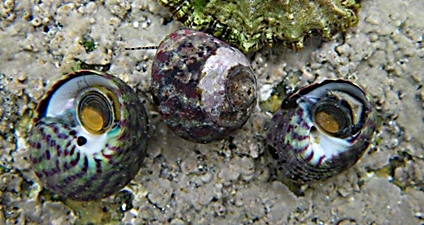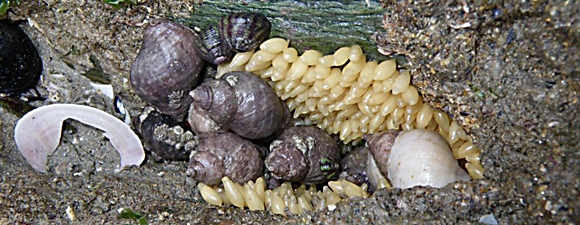
Umbilicate top shell (Gibbula umbilicalis). Very well visible: The shell lid (Operculum).
Picture: Florence Gully, Nature 22: Gastéropodes 2.
Concerning the number of their species, sea snails are noticeably overtaken by their land-living relatives (about 25,000 of 45,000 known gastropod species are terrestrial ones), but nevertheless there are many different forms of gastropods in the sea; sometimes it is hard to see, how they are related to terrestrial snails.
Especially in older literature, sea snails are placed either in the Prosobranchia or in the Opisthobranchia, depending on how far the torsion has proceeded and where the respiratory organs are placed (Prosobranchia: in front; Opisthobranchia: in the rear). However, in the meantime, the systematic term Prosobranchia has turned out to be obsolete, in fact, the Opisthobranchia are today opposed to several autonomous groups of prosobranch gastropods.
 Umbilicate top shell (Gibbula umbilicalis). Very well visible: The shell lid (Operculum). Picture: Florence Gully, Nature 22: Gastéropodes 2. |
What the various different groups of prosobranch gastropods have in common, is that in contrary to most terrestrial snails they only rarely are hermaphrodites, meaning they have separate sexes, and that they carry a shell lid (Operculum) on their foot tip, which closes the shell aperture, when the snail withdraws. They do have that in common with several terrestrial snail groups (such as the terrestrial operculate snails, Pomatiasidae), which again differ in that regard from the terrestrial pulmonate snails (Stylommatophora).
Sea snails can well be observed by the habitats they inhabit. Those may not be as various and also not as different on small distances, like on land (which is the reason for the very large number of terrestrial snail species), but nevertheless sea snails of the coastal region (the littoral) differ noticeably from their relatives of the high sea (pelagic) and the sea floor (benthic).
The North Se is a shelf sea, its maximal depth only 92 m (about 270 ft.). But there are wide Wadden Sea areas with a rich fauna of sea snails noticeably different from that of the French North West coast, influenced by the Atlantic. Comparing North Sea and Baltic Sea, there are several differences: First, there are almost no tides in the Baltic; they reach the Baltic only by the straits of the Lesser and Larger Belt. Likewise the salinity of the Baltic Sea is noticeably lower, as sea water has to come through the Belts, but fresh water comes from many tributary rivers. Additionally, because of the floor profile, salinity may differ regionally, so the snails living there are different from those of the North Sea, or only some special North Sea snails, such as the netted dog whelk (Hinia reticulata) are sufficiently adaptable to tolerate both North Sea and Baltic Sea water.
Third, the Mediterranean shows a completely different design, due to its geological history. Here, the Eurasian and the African continental plates collide, leading to the formation of a subduction zone in the Mediterranean, as well as the geologically young folding of the Alps' mountain range. In the Calypso deep, southwest of the Peloponnesus, the Mediterranean Sea reaches a depth of more than 5000 metres.
Very important for the formation of gastropod life also is the type of marine vegetation: Kelp forests and sea grass meadows have an importance for the global climate comparable to dry-earth forests; because of the abundance of nutrients, the fauna also is especially rich in species there.
 The predatory northern purple snail (Nucella lapillus) surrounded by capsules of freshly laid eggs. In between, some top shells (Gibbula spec.). Source: Florence Gully, Nature 22: Gastéropodes 2. |
The way of life of sea snails also is very different: There are grazers of algae, as well as carrion eaters and a large number of predatory species. Among the latter especially the spectacular cone shells (Conidae) are well known, which hunt their prey with a venom dart. In the Mediterranean this mainly tropical family is only represented with a few species.
One thing all sea snails have in common: They breathe with gills. Those can either be primordial, as in most marine gastropods, or they can have secondarily evolved, like the dorsal appendages of the nudibranch sea slugs.
![]() Gastropod morphology:
Respiration and Circulation.
Gastropod morphology:
Respiration and Circulation.
Numerous sea snail species are exploited by man. Findings from different eras of human history point towards this having been the case for millennia. It is hard to say, if the exploitation of sea shells evolved first or if molluscs had been collected from rivers and lakes as well. It is, however, provable, that since the Palaeolithic molluscs have been used as food, and also to manufacture jewellery.
On each of the following pages some groups from domestic seas, such as North Sea, Baltic Sea, Atlantic and Mediterranean, shall be described.
Some sea snail groups have been described more elaborately on special pages: